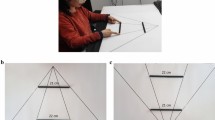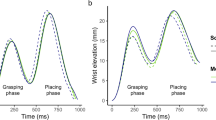Abstract
WHEN interacting with objects, the pattern of movements is influenced by such object characteristics as size and position1–4. Little is known about the effect of higher level categorical encoding of objects upon movements. Here we present evidence for an approval-for-action process which takes into account such encoding. For the brain-damaged subject L.P., the ability to complete actions involving two objects in central vision is influenced by the semantic or functional relationship between the objects. Even though she perceives only one object, she can integrate two related objects into a coordinated action. If the objects are not related she is unable to integrate them into a single motor act. We propose that selection-for-action systems5 include processes which gate conceptually the behavioural disposition to action.
This is a preview of subscription content, access via your institution
Access options
Subscribe to this journal
Receive 51 print issues and online access
$199.00 per year
only $3.90 per issue
Buy this article
- Purchase on Springer Link
- Instant access to full article PDF
Prices may be subject to local taxes which are calculated during checkout
Similar content being viewed by others
References
Jeannerod, M. in Attention and Performance Vol. IX (eds Long, J. & Baddeley, A.) 153–168 (Erlbaum, Hillsdale, 1981).
Jakobson, L. S. & Goodale, M. A. Expl Brain Res. 86, 199–208 (1991).
Castiello, U., Bennett, K. M. B. & Stelmach, G. E. Expl Brain Res. 94, 165–180 (1993).
Weir, P. L. in Insights into the Reach to Grasp Movement (eds Bennett, K. M. B. & Castiello, U.) 129–150 (North-Holland, Amsterdam, 1994).
Allport, A. in Perspectives on Perception and Action (eds, Heuer, H. & Sanders, A. F.) 395–419 (Erlbaum, Hillsdale, 1987).
Kinsbourne, M. & Warrington, E. K. Brain 86, 697–702 (1963).
Coslett, H. B. & Saffran, E. Brain 114, 1523–1545 (1991).
Humphreys, G. W. & Price, C. J. Cogn. Neuropsychol. 11, 393–434 (1994).
Warrington, E. K. & Shallice, T. Brain 107, 829–853 (1984).
Laiacona, M., Barbarotto, R. & Capitani, E. Cortex 29, 727–740 (1993).
Jeannerod, M., Decety, J. & Michel, F. Neuropsychologia 32, 369–380 (1994).
Milner, A. D. et al. Brain 114, 405–428 (1991).
DeYoe, E. A. & Van Essen, D. C. Trends Neurosci. 11, 219–226 (1988).
Goodale, M. A. & Milner, A. D. Trends Neurosci. 15, 20–25 (1992).
Goldman-Rakic, P. S. A. Rev. Neurosci. 11, 137–156 (1988).
Andersen, R. A. A. Rev. Neurosci. 12, 377–403 (1989).
Kinsbourne, M. & Warrington, E. K. Brain 85, 461–486 (1962).
Goodglass, H. & Kaplan, E. The Assessment of Aphasia and Related Disorders (Lea and Febiger, Philadelphia, 1972).
Kaplan, E., Goodglass, H. & Weintraub, S. Boston Naming Test. Experimental Edition (Boston Univ. Aphasia Research Center, Boston, 1982).
Snodgrass, J. G. & Vanderwart, M. J. exp. Psychol., hum. Learn. Mem. 6, 174–215 (1980).
Warrington, E. K. & Taylor, A. M. Perception 7, 695–705 (1978).
DeRenzi, E. in Neuropsychological Studies of Apraxia and Related Disorders (ed. Roy, E. A.) 45–64 (North-Holland, Amsterdam, 1985).
Perenin, M. T. & Vighetto, A. Brain 111, 643–674 (1988).
Ferrigno, G. & Pedotti, A. IEEE Trans. biomed. Engng. 32, 943–950 (1985).
Kelso, J. A. S., Holt, K. G., Kugler, P. N. & Turvey, M. T. in Tutorials in Motor Behavior (eds Stelmach, G. E. & Requin, J.) 49–70 (North-Holland, Amsterdam, 1980).
Arbib, M. A. in Handbook of Physiology, Section 1: The Nervous System, Vol. 2: Motor Control (ed. Brooks, V. B.) 1449–1480 (Williams and Wilkins, Baltimore, 1981).
Jeannerod, M. The Neural and Behavioural Organization of Goal-Directed Movements (Oxford Science Publications. No. 15, Clarendon Press, Oxford, 1988).
Author information
Authors and Affiliations
Rights and permissions
About this article
Cite this article
Castiello, U., Scarpa, M. & Bennett, K. A brain-damaged patient with an unusual perceptuomotor deficit. Nature 374, 805–808 (1995). https://doi.org/10.1038/374805a0
Received:
Accepted:
Issue Date:
DOI: https://doi.org/10.1038/374805a0
This article is cited by
-
Acting without 'seeing'
Nature (1995)
Comments
By submitting a comment you agree to abide by our Terms and Community Guidelines. If you find something abusive or that does not comply with our terms or guidelines please flag it as inappropriate.



